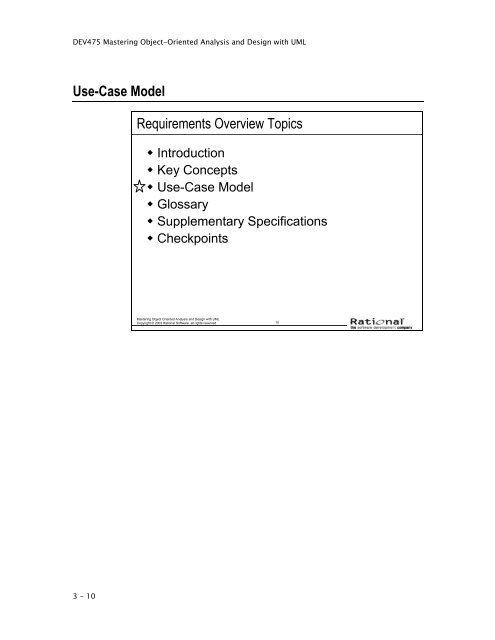DEV475 Mastering Object-Oriented Analysis and Design with UML ...
DEV475 Mastering Object-Oriented Analysis and Design with UML ... DEV475 Mastering Object-Oriented Analysis and Design with UML ...
DEV475 Mastering Object-Oriented Analysis and Design with UMLUse-Case ModelRequirements Overview Topics• Introduction• Key Concepts• Use-Case Model• Glossary• Supplementary Specifications• CheckpointsMastering Object Oriented Analysis and Design with UMLCopyright © 2003 Rational Software, all rights reserved 103 - 10
Module 3 - Requirements OverviewWhat Is a Use-Case Model?What Is a Use-Case Model?• A model that describes a system’s functionalrequirements in terms of use cases• A model of the system’s intended functionality(use cases) and its environment (actors)View Report CardRegister for CoursesStudentLoginMastering Object Oriented Analysis and Design with UMLCopyright © 2003 Rational Software, all rights reserved 11• A Use-Case Model describes a system’s functional requirements in terms of usecases. It is a model of the system's intended functionality and its environment.The Use-Case Model serves as a contract between the customer and thedevelopers. Because it is a very powerful planning instrument, the Use-CaseModel is generally used in all phases of the development cycle.• When the customer approves the Use-Case Model, you know the system is whatthe customer wants. You can also use the model to discuss the system with thecustomer during development.• Potential users use the Use-Case Model to better understand the system.• Designers use it as a basis for their work and to get a system overview.• Testers use it to plan testing activities (use case and integration testing) as early aspossible.• Those developing the next version of the system use it to understand how theexisting version works.• Documentation writers use the use cases as a basis for writing the system userguides.• The architect uses the Use-Case Model to identify architecturally significantfunctionality.• The manager uses it to plan and follow up on use-case modeling and subsequentdesign.3 - 11
- Page 74 and 75: DEV475 Mastering Object-Oriented An
- Page 76 and 77: DEV475 Mastering Object-Oriented An
- Page 78 and 79: DEV475 Mastering Object-Oriented An
- Page 80 and 81: DEV475 Mastering Object-Oriented An
- Page 82 and 83: DEV475 Mastering Object-Oriented An
- Page 84 and 85: DEV475 Mastering Object-Oriented An
- Page 86 and 87: DEV475 Mastering Object-Oriented An
- Page 88 and 89: DEV475 Mastering Object-Oriented An
- Page 90 and 91: DEV475 Mastering Object-Oriented An
- Page 92 and 93: DEV475 Mastering Object-Oriented An
- Page 94 and 95: DEV475 Mastering Object-Oriented An
- Page 96 and 97: DEV475 Mastering Object-Oriented An
- Page 98 and 99: DEV475 Mastering Object-Oriented An
- Page 100 and 101: DEV475 Mastering Object-Oriented An
- Page 102 and 103: DEV475 Mastering Object-Oriented An
- Page 104 and 105: DEV475 Mastering Object-Oriented An
- Page 106 and 107: DEV475 Mastering Object-Oriented An
- Page 108 and 109: DEV475 Mastering Object-Oriented An
- Page 110 and 111: DEV475 Mastering Object-Oriented An
- Page 112 and 113: DEV475 Mastering Object-Oriented An
- Page 114 and 115: DEV475 Mastering Object-Oriented An
- Page 116 and 117: DEV475 Mastering Object-Oriented An
- Page 118 and 119: DEV475 Mastering Object-Oriented An
- Page 120 and 121: DEV475 Mastering Object-Oriented An
- Page 122 and 123: DEV475 Mastering Object-Oriented An
- Page 126 and 127: DEV475 Mastering Object-Oriented An
- Page 128 and 129: DEV475 Mastering Object-Oriented An
- Page 130 and 131: DEV475 Mastering Object-Oriented An
- Page 132 and 133: DEV475 Mastering Object-Oriented An
- Page 134 and 135: DEV475 Mastering Object-Oriented An
- Page 136 and 137: DEV475 Mastering Object-Oriented An
- Page 138 and 139: DEV475 Mastering Object-Oriented An
- Page 140 and 141: DEV475 Mastering Object-Oriented An
- Page 142 and 143: DEV475 Mastering Object-Oriented An
- Page 144 and 145: DEV475 Mastering Object-Oriented An
- Page 146 and 147: DEV475 Mastering Object-Oriented An
- Page 148 and 149: DEV475 Mastering Object-Oriented An
- Page 150 and 151: DEV475 Mastering Object-Oriented An
- Page 152 and 153: DEV475 Mastering Object-Oriented An
- Page 154 and 155: DEV475 Mastering Object-Oriented An
- Page 156 and 157: DEV475 Mastering Object-Oriented An
- Page 158 and 159: DEV475 Mastering Object-Oriented An
- Page 160 and 161: DEV475 Mastering Object-Oriented An
- Page 162 and 163: DEV475 Mastering Object-Oriented An
- Page 164 and 165: DEV475 Mastering Object-Oriented An
- Page 166 and 167: DEV475 Mastering Object-Oriented An
- Page 168 and 169: DEV475 Mastering Object-Oriented An
- Page 170 and 171: DEV475 Mastering Object-Oriented An
- Page 172 and 173: DEV475 Mastering Object-Oriented An
<strong>DEV475</strong> <strong>Mastering</strong> <strong>Object</strong>-<strong>Oriented</strong> <strong>Analysis</strong> <strong>and</strong> <strong>Design</strong> <strong>with</strong> <strong>UML</strong>Use-Case ModelRequirements Overview Topics• Introduction• Key Concepts• Use-Case Model• Glossary• Supplementary Specifications• Checkpoints<strong>Mastering</strong> <strong>Object</strong> <strong>Oriented</strong> <strong>Analysis</strong> <strong>and</strong> <strong>Design</strong> <strong>with</strong> <strong>UML</strong>Copyright © 2003 Rational Software, all rights reserved 103 - 10



